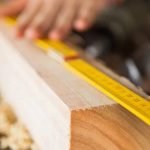Woodworking is a craft that has been practiced for centuries, allowing individuals to create beautiful and functional pieces from the natural material. However, one key aspect of woodworking often overlooked or underestimated is the drying process of the wood.
Properly drying wood is essential for successful woodworking projects, as it not only affects the durability and stability of the finished piece but also influences its appearance and overall quality. In this article, we will explore the importance of drying wood for woodworking, understand wood moisture content and its impact, learn about different methods to dry wood effectively, and discover best practices for handling and storing dried wood.
Using improperly dried wood can have detrimental effects on a woodworking project. The moisture content of the wood significantly impacts its dimensional stability and structural integrity. Wood that hasn’t been adequately dried may warp or crack over time as it continues to lose moisture. Additionally, improper drying can lead to mold growth on the surface or inside the wood, compromising its strength and aesthetics.
Understanding wood moisture content is crucial in ensuring its suitability for use in woodworking projects. Wood moisture content refers to the amount of water present in the wood fibers relative to its weight or volume.
Achieving an appropriate moisture content before using wood in projects is vital because excessive moisture can cause warping during drying or after construction when exposed to varying environmental conditions. On the other hand, if the moisture content is too low, it may result in shrinkage or splitting when brought into contact with higher humidity levels.
To achieve optimal results in woodworking, various methods can be employed to dry wood effectively. Air drying, kiln drying, and using a moisture meter are some commonly used techniques that offer different advantages based on available resources and desired outcomes. Each method has its own set of benefits and drawbacks that need to be considered when choosing how to dry your wood.
Properly drying wood for woodworking involves many considerations – from selecting suitable methods for specific types of woods to taking necessary steps to prevent common issues like mold growth and excessive moisture. By mastering the art of wood drying, woodworkers can ensure their projects are not only visually appealing but also durable and long-lasting.
In the following sections of this article, we will delve into each aspect in detail, providing step-by-step guides, troubleshooting tips, and expert recommendations for achieving optimal results when drying wood for woodworking projects.
Understanding Wood Moisture Content and Why It Matters
Wood moisture content plays a crucial role in any woodworking project. It refers to the amount of water present in wood, typically expressed as a percentage of the weight of the wood compared to its oven-dry weight. Understanding wood moisture content is essential for several reasons.
Firstly, wood moisture content affects the strength and stability of the finished product. When working with wood that has not been adequately dried, it is more prone to warping, cracking, and other types of deformation. This can result in a poorly constructed piece and can lead to significant problems down the line. By achieving the appropriate moisture content before using wood in projects, you can ensure that your finished product will be sturdy and durable.
Secondly, improper wood moisture content can also lead to mold growth. Mold thrives in moist environments, and if the wood used in a project retains too much water, it creates an ideal breeding ground for mold spores. Not only is mold unsightly and can adversely affect the aesthetics of a woodworking project but it can also pose health risks to both the maker and end-users if not addressed promptly.
To avoid these negative consequences, it is crucial to measure and control the moisture content of your wood before incorporating it into your woodworking projects. One effective way to achieve this is by using a moisture meter. A moisture meter is a simple handheld device that allows you to accurately measure the moisture levels within your wood.
By regularly monitoring the moisture content throughout the drying process, you can ensure that your wood reaches an appropriate level before use. Additionally, a moisture meter can help identify potential issues such as hidden pockets of excessive humidity or areas where drying may be uneven.
Different Methods to Dry Wood for Woodworking
Wood drying is a crucial step in the woodworking process, as it significantly affects the quality and durability of the final product. There are several methods available for drying wood, each with its own advantages and disadvantages. By understanding these different methods, woodworkers can choose the most suitable technique based on their resources and the specific characteristics of the wood they are working with.
One commonly used method is air drying, which involves exposing freshly cut wood to natural air circulation until it reaches the desired moisture content. Air drying is a cost-effective option that requires minimal equipment. However, it can be a slow process, taking months or even years depending on the thickness of the wood and environmental conditions. It’s important to stack and store the lumber properly during air drying to ensure even airflow and prevent issues like mold growth.
Kiln drying is another popular method that offers faster and more controlled results. In kiln drying, wood is placed in a specialized chamber where temperature, humidity, and airflow are carefully regulated using heating elements or fans. Kiln drying allows for precise control over moisture content and reduces the risk of defects such as warping or cracking. However, it does require additional equipment and energy consumption.
Using a moisture meter is also an effective way to determine the moisture content of wood during the drying process. A moisture meter measures electrical resistance or conductivity within the wood to provide an accurate reading of its water content. This method allows woodworkers to monitor progress and ensure that their material has reached the appropriate moisture level before beginning any woodworking project.
| Wood Drying Method | Advantages | Disadvantages |
|---|---|---|
| Air Drying | Cost-effective, minimal equipment required | Slow process, longer drying times |
| Kiln Drying | Faster drying times, controlled environment | Requires additional equipment and energy consumption |
| Using a Moisture Meter | Accurate readings, allows for monitoring progress | Does not actively dry wood; used in conjunction with other methods |
It is important to note that the choice of wood drying method depends on various factors such as available resources, time constraints, and the specific characteristics of the wood being dried. Each method has its own considerations and should be chosen accordingly. By selecting the right drying technique and ensuring proper moisture content, woodworkers can achieve optimal results in their woodworking projects.
Step-by-Step Guide
Air drying wood is a simple and cost-effective method for drying wood for woodworking projects. This method involves allowing the wood to naturally dry over time, using the air and surrounding environment to facilitate the drying process. Here is a step-by-step guide on how to air dry wood for woodworking:
- Harvesting: Start by harvesting the wood you want to dry. It is important to harvest the wood during the appropriate season, when the moisture content in the trees is at its lowest. This will help expedite the drying process.
- Preparing: Once harvested, remove any branches, bark, or leaves from the wood. This will reduce mold growth and allow for better airflow during drying. Cut the wood into desired sizes and seal any freshly cut ends with a wax-based sealer or paint to prevent excessive moisture loss through these areas.
- Selecting a Location: Find an appropriate location for air drying your wood. Ideally, this location should have good airflow, shade, and protection from direct sunlight and rain. A covered area or open-sided structure like a shed or garage works well.
- Stacking: Stack the lumber in a way that allows air circulation between each piece of wood. Place sticks or spacers between each layer of stacked wood to promote even drying and prevent warping. Make sure there is enough space between each board for air movement.
- Monitoring Moisture Levels: Regularly monitor the moisture levels in your wood using a moisture meter. Aim for a moisture content of around 8-12% for most woodworking projects. Check different pieces of lumber as they may dry at different rates.
- Patience & Time: Air drying can take several months to a year depending on factors such as humidity, climate, and thickness of the wood pieces being dried. Be patient and allow sufficient time for the wood to reach its desired moisture content before using it in your woodworking projects.
By following these steps, you can successfully air dry wood for your woodworking projects. It is important to note that air drying may not be suitable for all types of wood or in certain climates. In such cases, alternative drying methods like kiln drying may be more appropriate.
Utilizing Kiln Drying for Efficient Wood Drying
Kiln drying is a highly efficient method of drying wood for woodworking projects. Unlike air drying, which relies on natural ambient conditions to slowly evaporate moisture from the wood, kiln drying uses controlled heat and humidity to accelerate the drying process. This results in faster and more consistent drying times, making kiln drying an attractive option for those with time constraints or large quantities of wood to dry.
The Benefits of Kiln Drying
There are several benefits to utilizing kiln drying for woodworking projects. Firstly, kiln dried wood has a more predictable moisture content compared to air-dried wood. This consistency allows woodworkers to have greater control over how the wood behaves during construction and reduces the risk of warping or cracking once the project is complete.
Additionally, eliminating excessive moisture content through kiln drying helps prevent mold and fungal growth. The controlled environment within a kiln inhibits the conditions necessary for mold spores to thrive, reducing the risk of damage to both the wood and any finished products.
Kiln drying also minimizes defects that can occur during air-drying processes, such as surface checking or end splitting. By rapidly removing moisture from the wood in a controlled manner, these issues are significantly reduced, resulting in higher-quality lumber for woodworking projects.
The Kiln Drying Process
In order to effectively utilize kiln drying, it’s important to understand the process involved. Kilns typically consist of a chamber with heating elements that generate warm air and a control system that regulates temperature and humidity levels.
The first step in the kiln drying process is preheating. This involves gradually raising the temperature inside the kiln while keeping humidity levels high. Preheating helps drive out initial surface moisture from the wood without causing excessive stress or damage.
Once preheating is complete, the temperature inside the kiln is increased to accelerate the drying process. The combination of heat and controlled humidity reduces the wood’s moisture content at a faster rate than natural air drying. This stage can take anywhere from a few days to several weeks, depending on factors such as the thickness and species of the wood.
After the desired moisture content is achieved, a cooling phase follows, allowing the wood to acclimate gradually to ambient conditions without inducing stress or moisture reabsorption. Once cooled, the wood is ready for woodworking projects.
Types of Kilns
There are various types of kilns available for wood drying, each with its own advantages and drawbacks.
- Chamber Kilns: These are small-scale kilns that are suitable for personal or small business use. They are easy to operate and allow for precise control over temperature and humidity levels.
- Track Kilns: Ideal for larger-scale operations, track kilns consist of multiple chambers arranged in a track system. This allows for continuous loading and unloading of lumber, maximizing efficiency.
- Container Kilns: Container kilns are portable units built inside shipping containers. They provide flexibility and mobility for temporary or remote drying operations.
- Solar Kilns: As the name suggests, solar kilns utilize solar energy as the heat source for drying wood. They can be cost-effective and environmentally friendly options, particularly in sunny regions.
Before deciding on a specific type of kiln, it’s important to consider factors such as budget, available space, desired drying capacity, and local climate conditions.
By utilizing kiln drying methods, woodworkers can more efficiently dry their lumber while maintaining consistent moisture content throughout their woodworking projects. Whether using a small chamber kiln or a larger track or container system, proper understanding of the kiln drying process will enhance overall woodworking results while saving time and minimizing potential issues associated with improperly dried wood.
Best Practices for Drying Specific Types of Wood
Wood drying is a crucial step in woodworking, and it becomes even more important when considering the specific characteristics of different types of wood. Each wood species has its unique properties that affect how it should be dried to achieve the best results. Understanding the specific requirements for drying different woods can help prevent issues like warping, cracking, or uneven drying.
When drying oak, it is essential to take into account its density and tendency to crack. Oak should be air-dried slowly to allow for a gradual reduction in moisture content and minimize cracking. It is recommended to seal the ends of oak boards with wax or paint to prevent excessive moisture loss and reduce end checking.
Pine, on the other hand, dries relatively quickly but has a greater tendency to warp compared to other woods. To achieve optimal results when drying pine, using kiln drying or a combination of air-drying and kiln-drying methods is recommended. Controlling the temperature and humidity during the drying process is crucial for preventing warping in pine.
Maple is another popular wood used in woodworking projects. It is prone to staining or discoloration if not dried properly. To ensure successful drying of maple, it is important to control both temperature and humidity carefully. Air-drying maple can be challenging due to its density, so using a kiln or dehumidifier can expedite the process while still achieving desired results.
Overall, understanding the specific characteristics of each type of wood is vital when determining the best practices for drying them. By following these recommendations and considering factors such as density, cracking tendencies, and potential discoloration, woodworkers can achieve optimal results in their projects while minimizing issues during the drying process.
| Wood Species | Best Drying Practices |
|---|---|
| Oak | Air dry slowly to minimize cracking, seal the ends with wax or paint |
| Pine | Use kiln drying or a combination of air-drying and kiln-drying, control temperature and humidity to prevent warping |
| Maple | Control temperature and humidity carefully, consider using a kiln or dehumidifier to expedite the drying process |
Proper Storage and Handling of Dried Wood
After investing time and effort into properly drying wood for woodworking projects, it is crucial to ensure that the wood is stored and handled correctly to maintain its moisture content and prevent any damage. In this section, we will discuss the significance of proper storage and handling techniques after wood has been dried, provide tips for storing wood, and explain how to handle dried wood to avoid potential issues.
Tips for Storing Wood
Storing dried wood correctly is essential for maintaining its moisture content and preventing it from absorbing excess moisture or becoming damaged. Here are some tips to keep in mind when storing your dried wood:
- Keep it dry: It is crucial to store dried wood in a dry environment with low humidity levels. Moisture can easily be absorbed by the wood if exposed to a damp or humid atmosphere.
- Proper ventilation: Ensure that there is adequate air circulation around the stored wood. This helps prevent mold growth or mildew formation due to excessive moisture trapped between stacked pieces.
- Elevated storage: Place wooden boards on supports or racks that allow air circulation beneath them. By keeping them off the ground, you can minimize the risk of moisture absorption from contact with damp surfaces.
Handling Dried Wood
Proper handling of dried wood is just as important as storing it correctly. Improper handling can lead to scratching, warping, or other damage that may affect the quality of your woodworking project. Consider these tips when handling dried wood:
- Avoid dropping or dragging: Handle wooden boards with care, avoiding any sudden impacts or dragging them against rough surfaces that may cause scratches or splinters.
- Support long boards: When moving longer pieces of lumber, support both ends adequately to prevent flexing or bowing under their weight.
- Acclimate before use: If you have stored your dried wood in a different location than where it will be used, allow the wood to acclimate to its new environment for a reasonable amount of time before starting your woodworking project. This allows the wood to adjust to the moisture levels and reduce the risk of warping or cracking.
By following these storage and handling tips, you can ensure that your hard work in properly drying wood pays off. Taking the necessary precautions will help maintain the quality and condition of your dried wood, ensuring optimal results in your woodworking projects.
Troubleshooting Common Wood Drying Problems
Properly drying wood for woodworking projects is essential to ensure optimal results. However, there can be various challenges and issues that arise during the wood drying process. This section will address common problems that woodworkers may encounter and provide solutions and tips to overcome these issues.
One common problem is mold growth on the wood. Mold thrives in moist environments, making it important to control the moisture levels during the drying process. If mold does appear on the wood, it is crucial to address it promptly to prevent further damage and health risks.
To combat mold growth, ensure proper ventilation and airflow around the drying wood. Additionally, regularly monitor the moisture levels using a moisture meter and adjust humidity levels accordingly. If mold does develop, clean it off using a gentle solution of water and bleach or vinegar.
Excessive moisture in the wood is another challenge that can lead to warping, cracking, or decay in finished projects. This issue can occur due to improper drying techniques or inadequate monitoring of moisture levels. To prevent excessive moisture, accurately measure and control humidity levels during drying. Allow sufficient time for air circulation around stacked lumber during air drying or use appropriate settings in kiln drying methods. Regularly check moisture content using a moisture meter until desired levels are achieved.
Another common problem is when wood dries too quickly, resulting in defects like checking or splitting. Rapid drying can cause stress within the wood fibers, leading to these issues. To prevent rapid drying, select appropriate locations for air drying where temperature variations are minimal and direct sunlight is avoided. When using kilns for drying, follow recommended schedules provided by kiln manufacturers to ensure gradual and controlled drying.
By being aware of these common problems during the wood drying process and implementing appropriate measures to troubleshoot them, woodworkers can achieve optimal results with their woodworking projects. Remember to regularly monitor moisture levels using a reliable tool like a moisture meter and make necessary adjustments to humidity and temperature conditions. Taking the time to troubleshoot and address any issues that arise will result in beautifully dried wood ready for woodworking projects.
Conclusion
In conclusion, understanding and properly drying wood is essential for achieving optimal results in woodworking projects. Throughout this article, we have highlighted the importance of drying wood and discussed the negative consequences that can arise from using improperly dried wood. We have also explored different methods for drying wood, including air drying and kiln drying, providing tips and guidelines for choosing the most suitable method based on the type of wood and available resources.
Mastering the art of wood drying involves understanding the concept of wood moisture content and its impact on woodworking. Achieving the appropriate moisture content before using wood in projects is crucial to prevent issues like warping, cracking, and mold growth. By following step-by-step guides for air drying or utilizing kiln drying techniques, woodworkers can ensure that their lumber is properly seasoned and ready to be used.
It is also important to pay attention to proper storage and handling techniques after wood has been dried. Storing wood correctly will help maintain its moisture content and prevent damage. Additionally, handling dried wood with care can prevent scratching, warping, and other potential issues.

Hi everyone! I’m a woodworker and blogger, and this is my woodworking blog. In my blog, I share tips and tricks for woodworkers of all skill levels, as well as project ideas that you can try yourself.





